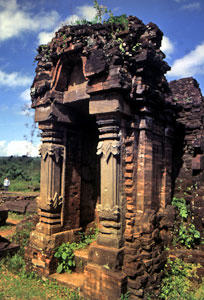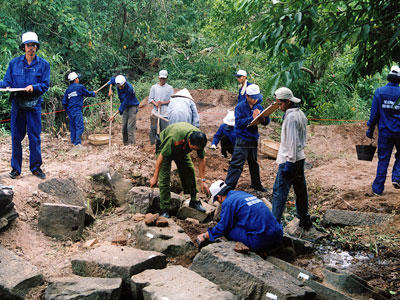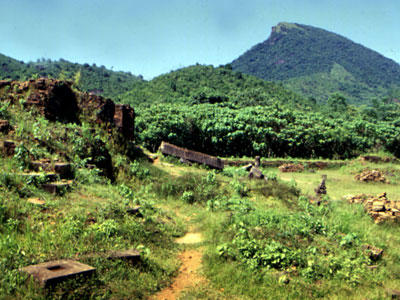My Son, an architectural complex on the coast of Vietnam, was the spiritual and political capital of the Cham people (the Champa Kingdom). The site consists of Hindu temple-towers built between the 4th and 13th centuries, though few pre-7th-century remains survive. The towers are built of bricks and held together by a vegetable-based cement. It is believed that upon the completion of a tower, a vast kiln was built around the structure and lit to “fire” it, rendering it more stable. French archaeologists working at the site in the early 20th century provided extensive and valuable documentation of the structures. The first western investigators at the site, they developed the lettering and number system that is still used to identify the temple-towers. During the Vietnam War, My Son was used by the Vietcong as a field headquarters. This resulted in a US bombing raid in 1969 that destroyed the most important temple at the site and damaged several others. Today, 30 temples survive and are in various states of ruin due to the destabilizing effects of invasive biological growth and frequently flooding streams nearby. More recently, international archaeological conservation teams have worked at the site to improve conditions and provide greater interpretation for visitors.
1996, 1998, and 2000 World Monuments Watch
Inclusion on the Watch in 1996, 1998, and 2000 raised international awareness of the My Son Temple District. In 2002, through funding from American Express, WMF organized archaeological and geological surveys undertaken by the Quảng Nam Center for Monuments and Heritage Conservation. At that time, a wide collection of stone, brick, terracotta, and porcelain objects were found. Although the initial goal of the excavation was to prepare the site for embankment of the Khethe stream, the resulting research provided considerable new information on the significance of My Son. WMF guided the center through the creation of a new dam and drainage system to improve protective measures against flooding, landslides, and subsequent water damage.
In spite of substantial loss due to environmental factors and the effects of war, a great deal still remains of what was once the capital city of the Cham kingdom. The surviving temple-towers still comprise the oldest and largest built relics in the history of Champa society. Among the dozens of partially surviving temples, 31 steles were discovered. Dating between the 5th and 12th centuries, the steles are decorated with Sanskrit and Cham carvings, which provide insight into the development of the site from religious origins in the Indian subcontinent.



